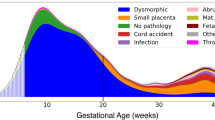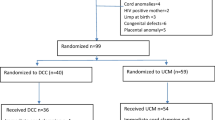Abstract
Purpose
To investigate whether women with a short cervical length (CL), but delivered at term in the first pregnancy might have increased risks of having short cervix and spontaneous preterm birth (sPTB) in the subsequent pregnancies.
Methods
This is a retrospective cohort study including singleton gestations who were delivered between Jan 2011 and Dec 2018, who had had one childbirth experience and who had transvaginal sonographic CL assessment performed at mid-trimester (18 ~ 30 weeks) in both pregnancy. The women were divided into four group according to the history of preterm birth and a short cervix (< 25 mm before 30 weeks of gestation): (1) the Preterm-short cervix group, (2) the Preterm-no shortening group, (3) the Term-short cervix group, and (4) the Term-no shortening group. We compared the risk of having short cervix and sPTB during the second pregnancy of women. Secondary outcomes were threatened preterm labor, need for tocolytics, and cerclage placement.
Results
A total of 804 women met our inclusion criteria. The rate of having short cervix (< 25 mm before 28 weeks of gestation) during the second pregnancy in women in the Term-short cervix group (43.2%) was significantly higher than those in women in the Term-no shortening group (6.6%), and in the Preterm-no shortening group (8.8%) (all p < 0.001 with Bonferroni correction), but not higher than those in women with the Preterm-short cervix group (30.8%, p > 0.05 with Bonferroni correction). When compared with women in the Preterm-no shortening group, women in the Term-short cervix group were also at an increased risk of need for need of tocolytics (60.2% vs. 26.5%) and cerclage placement (15.9% vs. 6.1%, all p < 0.001). Women in the Term-short cervix group had an increased risk of sPTB (< 37 weeks) during the second pregnancy, as compared to those in the Term-no shortening group (adjusted odds ratio 5.098, 95% CI 2.107–11.874).
Conclusion
Women with a history of short cervix in their first pregnancy, but who delivered at term, were at increased risk of having a short cervix and sPTB in their second pregnancy, as compared to women with a history of term delivery without cervical shortening. Thus, short cervix of the previous pregnancy might be a predictive factors for preterm birth in the subsequent pregnancy.


Similar content being viewed by others
Availability of data and materials
All data and code supporting the conclusion of the article are available from the corresponding author on reasonable request.
Code Availability
Not applicable.
References
Blencowe H, Cousens S, Jassir FB et al (2016) National, regional, and worldwide estimates of stillbirth rates in 2015, with trends from 2000: a systematic analysis. Lancet Glob Health 4(2):e98–e108
Alexander GR, Kogan M, Bader D, Carlo W, Allen M, Mor J (2003) US birth weight/gestational age-specific neonatal mortality: 1995–1997 rates for whites, hispanics, and blacks. Pediatrics 111(1):e61-66
Lamont RF, Jorgensen JS (2019) Safety and efficacy of tocolytics for the treatment of spontaneous preterm labour. Curr Pharm Des 25(5):577–592
Keelan JA, Newnham JP (2017) Recent advances in the prevention of preterm birth. F1000Res 6:F1000 Faculty Rev-1139
Iams JD, Goldenberg RL, Mercer BM et al (1998) The preterm prediction study: recurrence risk of spontaneous preterm birth. National institute of child health and human development maternal-fetal medicine units network. Am J Obstet Gynecol 178(5):1035–1040
Bloom SL, Yost NP, McIntire DD, Leveno KJ (2001) Recurrence of preterm birth in singleton and twin pregnancies. Obstet Gynecol 98(3):379–385
Iams JD, Goldenberg RL, Meis PJ et al (1996) The length of the cervix and the risk of spontaneous premature delivery. National institute of child health and human development maternal fetal medicine unit network. N Engl J Med 334(9):567–572
Meis PJ, Klebanoff M, Thom E et al (2003) Prevention of recurrent preterm delivery by 17 alpha-hydroxyprogesterone caproate. N Engl J Med 348(24):2379–2385
Owen J, Hankins G, Iams JD et al (2009) Multicenter randomized trial of cerclage for preterm birth prevention in high-risk women with shortened midtrimester cervical length. Am J Obstet Gynecol 201(4):375.e371-378
Committee on Practice Bulletins—Obstetrics, The American College of Obstetricians and Gynecologists (2012) Practice bulletin no. 130: prediction and prevention of preterm birth. Obstet Gynecol 120(4):964–973
Crane JM, Hutchens D (2011) Transvaginal ultrasonographic measurement of cervical length in asymptomatic high-risk women with a short cervical length in the previous pregnancy. Ultrasound Obstet Gynecol 38(1):38–43
Lee JK, Jang HL, Kang BH, Lee KS, Choi YS, Shim KS, Lim JW, Bae CW, Chung SH (2016) Percentile distributions of birth weight according to gestational ages in Korea (2010–2012). J Korean Med Sci 31(6):939–949
Mercer BM, Goldenberg RL, Moawad AH et al (1999) The preterm prediction study: effect of gestational age and cause of preterm birth on subsequent obstetric outcome. National institute of child health and human development maternal-fetal medicine units network. Am J Obstet Gynecol 181(5 Pt 1):1216–1221
Andersen HF, Nugent CE, Wanty SD, Hayashi RH (1990) Prediction of risk for preterm delivery by ultrasonographic measurement of cervical length. Am J Obstet Gynecol 163(3):859–867
Son M, Grobman WA, Ayala NK, Miller ES (2016) A universal mid-trimester transvaginal cervical length screening program and its associated reduced preterm birth rate. Am J Obstet Gynecol 214(3):365.e361-365
Boelig RC, Orzechowski KM, Berghella V (2016) Cervical length, risk factors, and delivery outcomes among women with spontaneous preterm birth. J Matern Fetal Neonatal Med 29(17):2840–2844
Funding
This study was supported by Research Fund of Seoul St. Mary’s Hospital, The Catholic University of Korea.
Author information
Authors and Affiliations
Contributions
JHW: Project development, data collection, manuscript writing, data analysis. JSL: Data collection. HSH: Data collection and Manuscript editing. JYK: Project development, supervision. HSK: Project development. IYP: Project development, manuscript editing. Supervision.
Corresponding author
Ethics declarations
Conflict of interest
All authors certify that they have no affiliations with or involvement in any organization or entity with any financial interest or non-financial interest in the subject matter or materials discussed in this manuscript.
Ethics approval
The Institutional Review Board of the Catholic University of Korea approved the present study.
Consent to participate
Not applicable.
Consent for publication
Not applicable.
Additional information
Publisher's Note
Springer Nature remains neutral with regard to jurisdictional claims in published maps and institutional affiliations.
Rights and permissions
About this article
Cite this article
Wie, J.H., Lee, J.S., Hwang, H.S. et al. The risk of preterm birth in women with history of short cervix delivering at term in the previous pregnancy: a retrospective cohort study. Arch Gynecol Obstet 305, 1151–1158 (2022). https://doi.org/10.1007/s00404-021-06202-8
Received:
Accepted:
Published:
Issue Date:
DOI: https://doi.org/10.1007/s00404-021-06202-8




